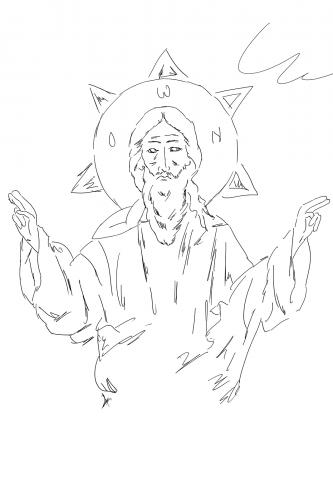



God the Father
As a consequence of the interdiction, inherited form Judaism, against the anthropomorfic imagery of the Divinity, and as a result of the phylosophical and theological inability to physically limit the Absolute, Christian art was, for a long period, quite hesitant how to represent God the Father.
Following the building of the first Christian basilica, during the 3rd.-5th. centuries, the new Christian iconography came into being, rapidly passing from the phase of taking over and processing iconographic motives of Greeko-Roman or Oriental origins to that of drawing up its own iconographic program. In this context, two solutions were found to the problem of representing the Divinity: either by representing Jesus as part of the Holy Trinity (accompanied in most of the cases by the Greek letters Omega, Omicron and Nu - ”o on” = ”The One who is”, translating one of the Old Testament's name of God), or by representing the Hand of God (see canon Hand of God), which comes out of the open skies and frequently blesses, but it may also reward with a martyr's crown, threaten or banish.
The Byzantine art developed new interpretations of the theme God the Father, strictly following the iconographic imagery mentioned above, as in the case of the allegorical theme of "the Ancient of Days" (Palaios Hemeron). However, Western art chose, as early as the 13th. century, to depict the Divinity anthropomorphically, like an elderly man with an unwrinkled face, adorned by long white hair and beard. Centuries later, a complex halo, made of the classic golden disk mounted over a star (frequently eight-pointed), or a triangle, was added in order to stress the Divinity uniqueness. The cruciger halo of Christ could also be employed, as in the case of "the Ancient of Days". Usually, this type of God's image is represented blessing with His right hand or both of the hands, sometimes holding the globus cruciger (in Post-Byzantine art the cross mounting the orb is missing), or, quite seldom, an open codex, the Gospel.
Under the influence of Western art, the anthropomorphic image of God the Father became usual in Post-Byzantine art, mainly from the 19th. century onwards, although earlier cases are known. The predilect themes for this kind of representation are The Lord of Hosts/Sabaoth (see canon Lord of Hosts) and the Holy Trinity (see canon Holy Trinity).
As a consequence of the interdiction, inherited form Judaism, against the anthropomorfic imagery of the Divinity, and as a result of the phylosophical and theological inability to physically limit the Absolute, Christian art was, for a long period, quite hesitant how to represent God the Father.
Following the building of the first Christian basilica, during the 3rd.-5th. centuries, the new Christian iconography came into being, rapidly passing from the phase of taking over and processing iconographic motives of Greeko-Roman or Oriental origins to that of drawing up its own iconographic program. In this context, two solutions were found to the problem of representing the Divinity: either by representing Jesus as part of the Holy Trinity (accompanied in most of the cases by the Greek letters Omega, Omicron and Nu - ”o on” = ”The One who is”, translating one of the Old Testament's name of God), or by representing the Hand of God (see canon Hand of God), which comes out of the open skies and frequently blesses, but it may also reward with a martyr's crown, threaten or banish.
The Byzantine art developed new interpretations of the theme God the Father, strictly following the iconographic imagery mentioned above, as in the case of the allegorical theme of "the Ancient of Days" (Palaios Hemeron). However, Western art chose, as early as the 13th. century, to depict the Divinity anthropomorphically, like an elderly man with an unwrinkled face, adorned by long white hair and beard. Centuries later, a complex halo, made of the classic golden disk mounted over a star (frequently eight-pointed), or a triangle, was added in order to stress the Divinity uniqueness. The cruciger halo of Christ could also be employed, as in the case of "the Ancient of Days". Usually, this type of God's image is represented blessing with His right hand or both of the hands, sometimes holding the globus cruciger (in Post-Byzantine art the cross mounting the orb is missing), or, quite seldom, an open codex, the Gospel.
Under the influence of Western art, the anthropomorphic image of God the Father became usual in Post-Byzantine art, mainly from the 19th. century onwards, although earlier cases are known. The predilect themes for this kind of representation are The Lord of Hosts/Sabaoth (see canon Lord of Hosts) and the Holy Trinity (see canon Holy Trinity).




